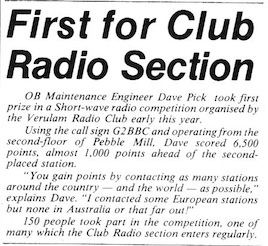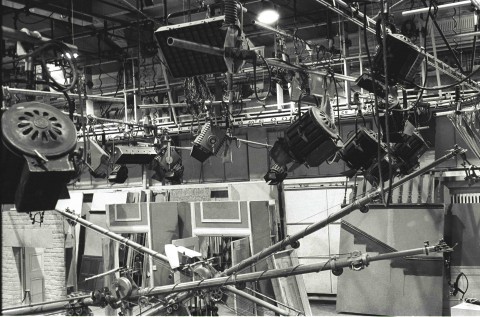Copyright resides with the original holder, no reproduction without permission.
This cutting is from the Pebble Mill News, March 1984. This was the internal staff newspaper.
The article tells how Dave Pick, an OB Maintenance Engineer at Pebble Mill, won a short-wave radio competition, by contacting more short-wave radio stations than any other competitor. He did all this from the 2nd floor of Pebble Mill.
The following comments were left on the Pebble Mill Facebook page:
Roy Thompson: ‘I think it was a popular past time for many engineers, John Endall I think was one. At Wood Norton there was a radio shack which was popular with trainee engineers and operators.’
Malcolm Hickman: ‘There were quite a few Radio Amateurs at Pebble Mill. Dave is still about.’
Thomas Graal: ‘We shortwave fans were well served back in the day….unlike now.’
David Ackrill: ‘Many organisations had Amateur Radio groups as part of their sports and social groups. I belonged to the MEB Radio Club (G6MEB and G4MEB) on Mucklow Hill, Halesowen. I became friends with Giles Herbert when he moved to Birmingham and lived just down the road from each other for a while. I worked the Children In Need special event station and still have a QSL card for the contact somewhere.’
Dave Pick: ‘Yes we had a radio room in what used to be the 2nd floor club’s bottle store. We had access to the roof for aerials (not so much health and safety then!). Who remembers that geodesic dome they tried to use for programmes up there? I still hold the G2BBC call sign. Radio club had quite a few members including Maurice Darkin, John Endall, Simon Evans, Frank Stevens, Malcolm Hickman and loads more.’
Jim Lee: ‘I remember having a few plays on G2BBC in the 90s with Dave and Giles in that store. I remember going up on to the roof as well – probably with Dave – where there was a Cobwebb and the top of a sloping 160m dipole.’
Brian Empringham: ‘Hi Jim, don’t know about Pebble Mill, but there were some hams at Bush – including the late George Eason – who worked out of some sort of shack on the roof.’


